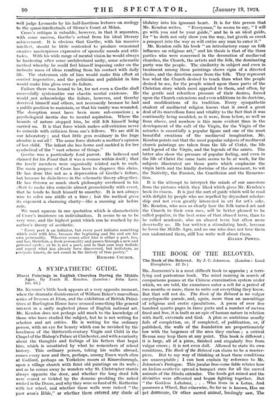A SYMPATHETIC GUIDE.
MR. KENDON'S little book appears at a very apposite moment, when the dramatic disinterment of William Baker's marvellous series of frescoes at Eton, and the exhibition of British Primi- tives at Burlington House have aroused something like general interest in a sadly neglected phase of English national art. Mr. Kendon does not perhaps add much to the knowledge of those who have studied the subject, but he is not writing for scholars and art critics. He is writing for the ordinary person, with an eye for beauty which can be ravished by the loveliness of the thirteenth-century Virgin and Child in the Chapel of the Bishop's Palace at Chichester, and with a curiosity about the thoughts and feelings of his fathers that begat him, which is unsatiated by what he remembers of school history. This ordinary person, taking his walks abroad, comes every now and then, perhaps, among Essex wych elms at Codford, perhaps on Yorkshire moors at Knaresborough, upon a village church with faint old paintings on its walls ; and as he comes away he wonders why St. Christopher stands always opposite the door, and whether the long dead folk were scared or tickled by the demons prodding the naked wicked in the Doom, and why they were so fond of St. Katherine with her wheel, and whether these walls were indeed " the poor moan's Bible," or whether there entered any shade of
idolatry into his ignorant heart. It is for this person that Mr. Kendon writes. " Everyman," he seems to say, " I will go with you and be your guide," and he is an ideal guide, for " he doth not only show you the way, but giveth so sweet a prospect into the way as will entice any man to enter it."
Mr. Kendon calls his book " an introductory essay on folk influence on religious art," and his thesis is that of the three
parties who were concerned in the decoration of mediaeval churches, the Church, the artists and the folk, the dominating party was the people. The similarity in subject and even in treatment among these paintings shows signs of a directed choice, and the direction came from the folk. They represent less what the Church desired to teach than what the people desired to see, for the people seized upon those parts of the Christian story which most appealed to them, and often, by the gentle and relentless pressure of their desires, forced upon the Church extensions and even additions to its doctrine, and modifications of its tradition. Every sympathetic student of mediaeval religion knows that it owed a great deal of its marvellous force and vitality to the fact that it was continually being moulded, as it were, from below, as well as from above, and nowhere is this more evident than in the development of the cult of the Virgin, for the Virgin of the miracles is essentially a popular figure and one of the most beautiful creations of the mediaeval imagination. Mr. Kendon points out that the most popular subjects of mediaeval church paintings are taken from the life of Christ, the life and legend of the Virgin, and the legends of the saints. The latter also show the pressure of popular feeling, and even in the life of Christ the same taste seems to be at work, for the subjects illustrated are those parts which emphasize the virgin birth and the kindly doctrine of the atonement, to wit the Nativity, the Passion, the Crucifixion and the Resurrec- tion.
It is the attempt to interpret the minds of our ancestors from the pictures which they liked which gives Mr. Kendon's book its charm. It is just the sort of guide which will be read with delight by people who are repelled by dryasdust scholar- ship and not even greatly interested in art for art's sake. Mr. Kendon, who sees so clearly how the folk turned art and the Church to their own uses, will be better pleased to be called popular, in the best sense of that abused term, than to be called academic, also an abused term but often more deservedly so. He has written a stimulating book, because he loves the Middle Ages, and no one who does not love them can understand them, still less write well about them.
EILEEN POWER.










































 Previous page
Previous page